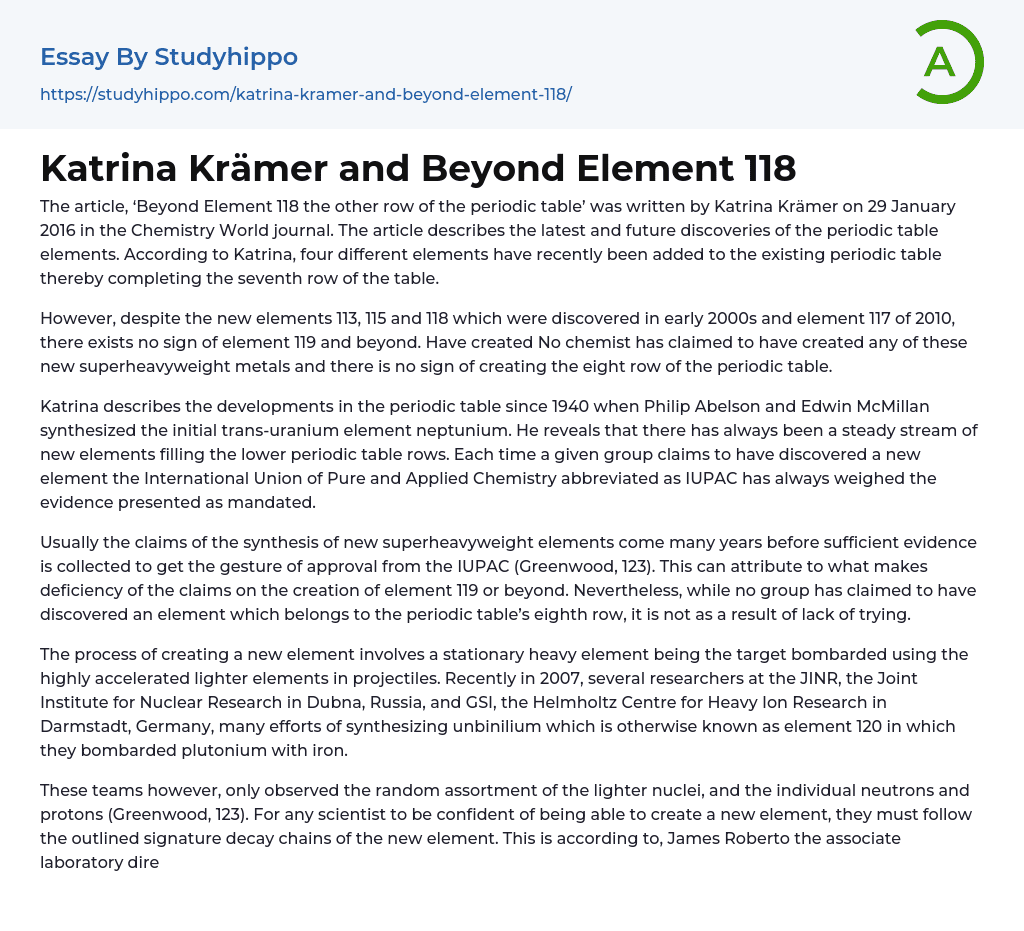The article, ‘Beyond Element 118 the other row of the periodic table’ was written by Katrina Krämer on 29 January 2016 in the Chemistry World journal. The article describes the latest and future discoveries of the periodic table elements. According to Katrina, four different elements have recently been added to the existing periodic table thereby completing the seventh row of the table.
However, despite the new elements 113, 115 and 118 which were discovered in early 2000s and element 117 of 2010, there exists no sign of element 119 and beyond. Have created No chemist has claimed to have created any of these new superheavyweight metals and there is no sign of creating the eight row of the periodic table.
Katrina describes the developments in the periodic table since 1940 when Philip Abelson and Edwin McMillan synthesized the initial tr
...ans-uranium element neptunium. He reveals that there has always been a steady stream of new elements filling the lower periodic table rows. Each time a given group claims to have discovered a new element the International Union of Pure and Applied Chemistry abbreviated as IUPAC has always weighed the evidence presented as mandated.
Usually the claims of the synthesis of new superheavyweight elements come many years before sufficient evidence is collected to get the gesture of approval from the IUPAC (Greenwood, 123). This can attribute to what makes deficiency of the claims on the creation of element 119 or beyond. Nevertheless, while no group has claimed to have discovered an element which belongs to the periodic table’s eighth row, it is not as a result of lack of trying.
The process of creating a new element involves a stationary heavy
element being the target bombarded using the highly accelerated lighter elements in projectiles. Recently in 2007, several researchers at the JINR, the Joint Institute for Nuclear Research in Dubna, Russia, and GSI, the Helmholtz Centre for Heavy Ion Research in Darmstadt, Germany, many efforts of synthesizing unbinilium which is otherwise known as element 120 in which they bombarded plutonium with iron.
These teams however, only observed the random assortment of the lighter nuclei, and the individual neutrons and protons (Greenwood, 123). For any scientist to be confident of being able to create a new element, they must follow the outlined signature decay chains of the new element. This is according to, James Roberto the associate laboratory director of Oak Ridge National Laboratory in the US.
The elements 114 to 118 were successfully created by firing the calcium projectiles towards the heavy actinide target. However, the likelihood of creating the heavier elements, those that are even heavier than elements 114 to 118, declines. The only option for providing the solution to this would be firing more projectiles to the target. The current accelerators send projectiles hitting the target at trillion projectiles per second; however, hitting the target with higher numbers of projectiles damages the target by burning it or the detector.
The target could also be made larger and spread the projectiles but making such actinide targets is difficult (Martins, 2007). 20g of berkelium for instance was synthesized for more than two years to produce element 117. The technologies are being placed to solve such problems; the super heavy element factory for instance is being built at Dubna to alleviate such challenges.
In conclusion, the article accurately explains the trend
and future of the developments in the periodic table and element discoveries. It shows that the super heavy elements have very short lifetime hence cannot be used in real world application. Scientists study them just to gain understanding of the atomic nucleus. Fuzzy logic calculations are also used to predict the behaviors of the undiscovered super heavy elements such as the element 120 124, 126, 137, 170 and 184 basing on the Einstein’s theory of relativity. They are predicted to decay so fast that they would only be used on a separate island.
- Acid essays
- Calcium essays
- Carbohydrate essays
- Carbon essays
- Chemical Bond essays
- Chemical Reaction essays
- Chemical reactions essays
- Chromatography essays
- Concentration essays
- Copper essays
- Diffusion essays
- Ethanol essays
- Hydrogen essays
- Organic Chemistry essays
- Osmosis essays
- Periodic Table essays
- Ph essays
- Salt essays
- Sodium essays
- Titration essays




